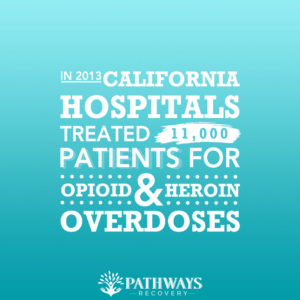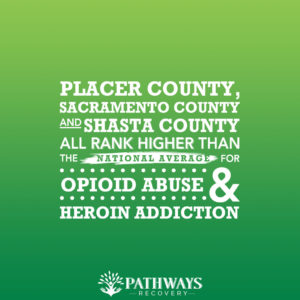
Recognizing The Scope Of The Problem
The National Institute on Drug Abuse (NIDA), a division of the National Institutes of Health, classifies opioid abuse and heroin addiction as an epidemic. NIDA estimates that in the United States, 2.1 million people abuse opioids and approximately 500,000 people are addicted to heroin. The number of prescription opioid-related deaths has quadrupled since 1999.
In 2013, California hospitals treated 11,500 patients for opioid and heroin overdoses. Every 45 minutes, a person in California overdoses. This staggering statistic represents a 50 percent increase from 2006. Hospitals in rural northern California see more overdoses than other parts of the state. Placer County, Sacramento County, and Shasta County all rank higher than the national average for opioid abuse and heroin addiction.
Opioid Prescriptions On The Rise
In 2001, The Joint Commission deemed pain the fifth vital sign in pain management. Physicians are required to manage pain effectively, based on a patient’s perceived pain scale. Hospitals evaluations consider how well the physicians do it.
As a result, opioid prescriptions have skyrocketed in the last two decades. In 1991, there were 76 million opioid prescriptions in the United States. In 2012, opioid prescriptions more than doubled to 207 million. Along with the surge in prescriptions, the number of emergency room visits related to abuse steadily rose, from 144,000 in 2004 to 305,000 in 2008. The United States is the largest consumer of opioids, accounting for 100 percent of the global supply of hydrocodone and 81 percent of oxycodone.
Increased opioid prescriptions mean greater access for teens and young adults in family homes. A doctor may dispense a 30-day prescription of Vicodin following surgery, but a patient may need pain relief for only a few days. Instead of disposing of the prescription, the leftover pills sit in a medicine cabinet at home.
How Opioids Become Drugs Of Abuse
Physicians commonly prescribe opioids for moderate-to-severe pain. They work by attaching to opioid receptors in the body, which both reduce the perception of pain and trigger a rush of endorphins, producing a sense of well-being. Endorphins are the body’s naturally occurring opioids.
As people continue to use synthetic opioids, the body begins to inhibit its own opioid-producing system. Users have to increase their dosages to experience the same effects, which leads to a dangerous cycle of building tolerance and increasing risk of overdose. This is how addiction develops.
Addictive Behaviors In Teens And Young Adults
When teens and young adults begin to abuse opioids, they may take the drugs in ways other than prescribed. For example, they may crush and snort the drugs to increase their effects and produce a rush of euphoria. Most oral opioids are extended-release pills, providing long-lasting pain relief and minimizing the risk of addiction. When someone crushes and snorts or smokes these pills, however, they put the body into overdrive, triggering a massive release of endorphins that leads teens and young adults to experience a high.
Opioids are alluring and dangerous for teens because they affect the reward center of the brain. This makes the drugs highly addicting. Because many of us keep opioids from old injuries or oral surgeries in our medicine cabinets, they’re easy for teens and young adults to obtain. The more potent the opioid, the easier the path to addiction is.
Opioids And Their Relationship To Heroin
As the opioid epidemic increases, so does access to heroin. Government officials have taken steps to curb opioid abuse by establishing new prescribing guidelines for physicians. Since it’s harder for many prescription pill abusers to get access to opioids, they turn to the next best thing: heroin, which is also an opioid.
Heroin use has skyrocketed in the past few years, with the number of past-year users doubling between 2005 and 2012. NIDA directly links increased heroin use to the opioid epidemic, because it is the next logical step in the addiction path. Heroin is cheaper and more readily available than prescription opioids. It provides a viable alternative to achieving the euphoric effect associated with mis-using pills.
Heroin is particularly dangerous because, unlike prescription drugs, there is no control over its purity. Heroin cut with fentanyl, a potent opioid, has found its way into local communities. When combined with other substances, heroin carries a higher risk of overdose and death. Anecdotal evidence suggests that heroin combined with fentanyl can bring about overdose within seconds of injection into a vein.
Heroin Affecting Teens
Statewide emergency room data shows that heroin use among young adults has risen sharply in recent years. It is a growing problem in northern California, though some areas have more problems than others do. Lincoln Police Chief Rex Marks notes that, although heroin isn’t as prevalent in his area as some other parts of the country, it was easy for teens to obtain.
Heroin once was a drug for the affluent. Now it is more affordable than meth, selling for $40 to $50 for a few grams. According to the County Sheriff’s Office, heroin use is up, based on possession arrests and deaths from overdose. The majority of victims are in their 20s.
Prescription Pill Abuse
According to data from the Drug Enforcement Agency, prescription pill abuse is rising among teens. Oxycodone is the most widely used and abused drug among 12- to 24-year-olds.
In Placer County, 11th-graders abuse prescription pills at a rate two times the national average. This sobering statistic should compel concerned parents, educators, and community leaders to act.
What Adults Can Do To Combat Opioid Abuse In Teens And Young Adults
Parents and educators can take simple steps to prevent prescription drug and heroin abuse in teens and young adults. One simple step is for parents to clear out their medicine cabinets. The Roseville Police Department recently coordinated an effort to take back prescription drugs from residents, and safely and effectively dispose of them. Their last event yielded over 9,000 pounds of prescription drugs.
Parental Efforts
According to the Coalition for Placer Youth, those who learn about drug risks from their parents are 50 percent less likely to use. Parents should not be afraid to talk with their teens about the dangers of opioid abuse and its path to riskier behaviors such as heroin addiction. Teens identify their parents as the #1 influence in their lives. Parents should provide guidance about possible negative consequences of opioid use and abuse.
The sheer availability of prescription drugs makes it possible for Placer County teens to experiment. Make sure to lock up all your current medications in a cabinet. Even if you trust your teen, their friends and acquaintances might not be so trustworthy.
Know The Consequences
The adverse outcomes associated with prescription drug abuse are severe. Respiratory distress, addiction, coma, brain damage, and death are all possibilities. Prescription drug experimentation may quickly devolve into heroin abuse, given its increased affordability and availability. Heroin and other intravenous drug use have their own consequences, including transmission of HIV and hepatitis C, among other blood-borne diseases from shared needles.
Act Quickly And Know The Signs
Parents, educators, and community leaders should be involved in a multifaceted effort to curb the threat of opioid and heroin abuse at the local and county levels. Parents should talk frankly to their children about the consequences. Educators should implement districtwide initiatives to inform the student body about the dangers of abusing prescription pills. Community leaders should encourage pill take-back programs and offer resources for parents to guide the conversation.
Prescription pill abuse and heroin addiction are preventable. We, as a community, should be aware of the threat heroin poses to our children and how readily accessible prescription pills are. According to the American Society of Addiction Medicine, 168,000 teens were addicted to pain medicine in 2014, and an additional 500,000 were using a pain reliever for nonmedical purposes. In 2014, nearly 30,000 teens aged 12 to 17 used heroin, and 18,000 became addicted.
Most adolescents who misuse prescription pain relievers get them at no cost from a friend or relative. Don’t let your teen be one of them. Talk to them about the dangers of drug abuse and the connection between prescription pills and heroin. Together, the residents of Placer County can address the issue head on, paving the way for healthier teens and brighter futures.
Need more information to help your teen or young adult with a drug or potential drug problem? Read here for additional options available to you.
Family Education Program
At Pathways Recovery in Sacramento, CA, we pride ourselves on the services we offer to those who are ready to take the next step to heal. Our services include, but not limited to, drug and alcohol treatment, heroin treatment, and opiate detox treatment. At Pathways Recovery, we also offer a holistic treatment plan for those who might need a little more assistance in our comfortable and safe drug and alcohol detox center located in a quite and friendly residential area. Contact us today for any questions or to speak with a highly trained member of our staff. The first step starts with a call today for a better tomorrow.



